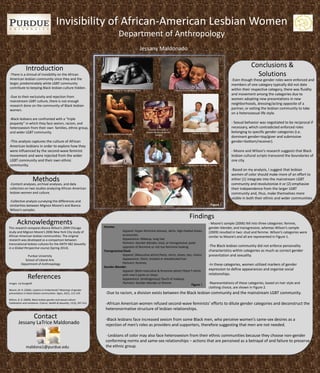
Updated African American Lesbians Poster
- 1. Invisibility of African-American Lesbian Women Department of Anthropology Jessany Maldonado Introduction Conclusions & Solutions Methods Findings Acknowledgments Contact Jessany LaTrice Maldonado This research compares Bianca Wilson’s 2009 Chicago study and Mignon Moore’s 2006 New York City study of African American lesbian communities. The original research was developed as a comparison between transnational lesbian cultures for the ANTH 482 Sexuality in a Global Perspective course (Spring 2014). Purdue University School of Liberal Arts Department of Anthropology -There is a shroud of invisibility on the African American lesbian community since they and the larger, predominately white LGBT community contribute to keeping Black lesbian culture hidden. -Due to their exclusivity and rejection from mainstream LGBT culture, there is not enough research done on the community of Black lesbian women. -Black lesbians are confronted with a “triple jeopardy” in which they face sexism, racism, and heterosexism from their own families, ethnic group, and wider LGBT community. -This analysis captures the culture of African American lesbians in order to explore how they were influenced by the second-wave feminist movement and were rejected from the wider LGBT community and their own ethnic community. -Even though these gender roles were enforced and members of one category typically did not date within their respective category, there was fluidity and movement among the categories due to women adopting new presentations in new neighborhoods, dressing/acting opposite of a partner, or exiting the lesbian community to take on a heterosexual life style. - Sexual behavior was negotiated to be reciprocal if necessary, which contradicted enforced roles belonging to specific gender categories (i.e. dominant gender=top/giver and submissive gender=bottom/receiver). - Moore and Wilson’s research suggests that Black lesbian cultural scripts transcend the boundaries of one city. -Based on my analysis, I suggest that lesbian women of color should make more of an effort to either (1) integrate into the mainstream LGBT community and revolutionize it or (2) emphasize their independence from the larger LGBT community and, thus, make themselves more visible in both their ethnic and wider communities. -Content analyses, archival analyses, and data collection on two studies analyzing African American lesbian women and culture. -Collective analysis surveying the differences and similarities between Mignon Moore’s and Bianca Wilson’s samples. maldona1@purdue.edu Femme: Apparel: Hyper-feminine dresses, skirts, high-heeled shoes, accessories Appearance: Makeup, long hair Partners: Gender-blender, stud, or transgressive; polar opposite of feminine or not too feminine looking Transgressive/Stud: Apparel: (Masculine attire) Pants, shirts, shoes, ties, chains Appearance: Short, braided or dreadlocked hair Partners: femmes Gender-Blender: Apparel: (Both masculine & feminine attire) Fitted T-shirts with men’s pants or shoes Appearance: (Androgynous) Touch of makeup Partners: Gender-blender or femme -Due to racism, a division exists between the Black lesbian community and the mainstream LGBT community. -African American women refused second-wave feminists’ efforts to dilute gender categories and deconstruct the heteronormative structure of lesbian relationships. -Black lesbians face increased sexism from some Black men, who perceive women’s same-sex desires as a rejection of men’s roles as providers and supporters, therefore suggesting that men are not needed. -Lesbians of color may also face heterosexism from their ethnic communities because they choose non-gender conforming norms and same-sex relationships – actions that are perceived as a betrayal of and failure to preserve the ethnic group. - Moore’s sample (2006) fell into three categories: femme, gender-blender, and transgressive, whereas Wilson’s sample (2009) resulted in two: stud and femme. Wilson’s categories were similar to Moore’s and all are represented in Figure 1. -The Black lesbian community did not enforce personality characteristics within categories as much as correct gender presentation and sexuality. -In these categories, women utilized markers of gender expression to define appearances and organize social relationships. -Representations of these categories, based on hair style and clothing choice, are shown in Figure 2. Figure 1 References Images via Google© Moore, M. R. (2006). Lipstick or timberlands? Meanings of gender presentation in black lesbian communities. Signs, 32(1), 113-139. Wilson, B. D. (2009). Black lesbian gender and sexual culture: Celebration and resistance. Culture, Health & Sexuality, 11(3), 297-313. Stud & Femme Femme & Stud /Transgressive Femme & Femme Femme/Gender-Blender & Femme Femme & Femme Femme & Femme or Gender-Blender & Gender- BlenderStud & Femme/Gender-Blender Femme & Transgressive /Stud Femme/Gender-Blender & Stud Figure 2